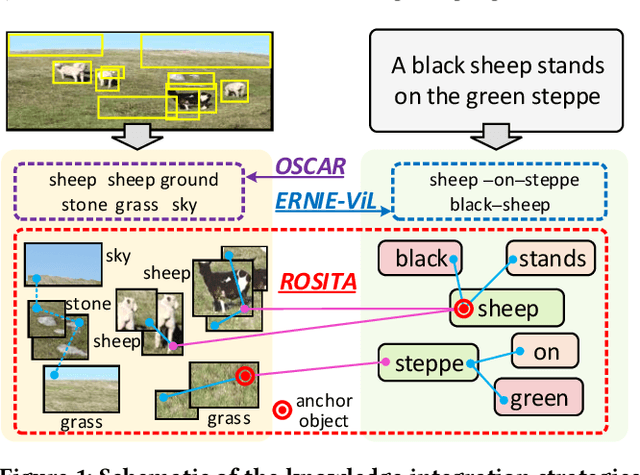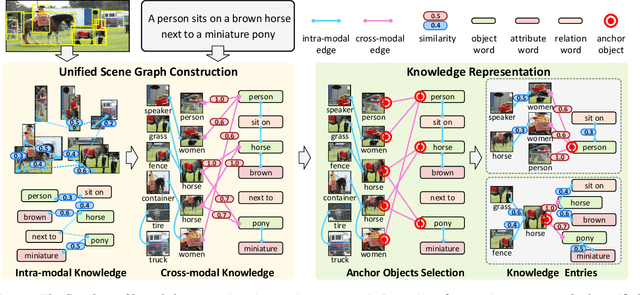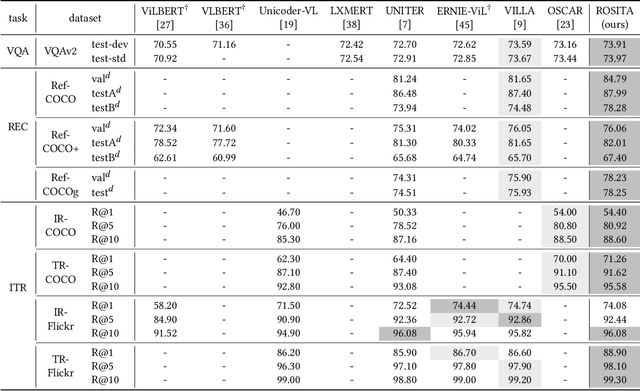Chunqi Wang
ROSITA: Enhancing Vision-and-Language Semantic Alignments via Cross- and Intra-modal Knowledge Integration
Aug 16, 2021



Abstract:Vision-and-language pretraining (VLP) aims to learn generic multimodal representations from massive image-text pairs. While various successful attempts have been proposed, learning fine-grained semantic alignments between image-text pairs plays a key role in their approaches. Nevertheless, most existing VLP approaches have not fully utilized the intrinsic knowledge within the image-text pairs, which limits the effectiveness of the learned alignments and further restricts the performance of their models. To this end, we introduce a new VLP method called ROSITA, which integrates the cross- and intra-modal knowledge in a unified scene graph to enhance the semantic alignments. Specifically, we introduce a novel structural knowledge masking (SKM) strategy to use the scene graph structure as a priori to perform masked language (region) modeling, which enhances the semantic alignments by eliminating the interference information within and across modalities. Extensive ablation studies and comprehensive analysis verifies the effectiveness of ROSITA in semantic alignments. Pretrained with both in-domain and out-of-domain datasets, ROSITA significantly outperforms existing state-of-the-art VLP methods on three typical vision-and-language tasks over six benchmark datasets.
Semi-Autoregressive Neural Machine Translation
Oct 27, 2018



Abstract:Existing approaches to neural machine translation are typically autoregressive models. While these models attain state-of-the-art translation quality, they are suffering from low parallelizability and thus slow at decoding long sequences. In this paper, we propose a novel model for fast sequence generation --- the semi-autoregressive Transformer (SAT). The SAT keeps the autoregressive property in global but relieves in local and thus is able to produce multiple successive words in parallel at each time step. Experiments conducted on English-German and Chinese-English translation tasks show that the SAT achieves a good balance between translation quality and decoding speed. On WMT'14 English-German translation, the SAT achieves 5.58$\times$ speedup while maintains 88\% translation quality, significantly better than the previous non-autoregressive methods. When produces two words at each time step, the SAT is almost lossless (only 1\% degeneration in BLEU score).
Convolutional Neural Network with Word Embeddings for Chinese Word Segmentation
Nov 13, 2017



Abstract:Character-based sequence labeling framework is flexible and efficient for Chinese word segmentation (CWS). Recently, many character-based neural models have been applied to CWS. While they obtain good performance, they have two obvious weaknesses. The first is that they heavily rely on manually designed bigram feature, i.e. they are not good at capturing n-gram features automatically. The second is that they make no use of full word information. For the first weakness, we propose a convolutional neural model, which is able to capture rich n-gram features without any feature engineering. For the second one, we propose an effective approach to integrate the proposed model with word embeddings. We evaluate the model on two benchmark datasets: PKU and MSR. Without any feature engineering, the model obtains competitive performance -- 95.7% on PKU and 97.3% on MSR. Armed with word embeddings, the model achieves state-of-the-art performance on both datasets -- 96.5% on PKU and 98.0% on MSR, without using any external labeled resource.
 Add to Chrome
Add to Chrome Add to Firefox
Add to Firefox Add to Edge
Add to Edge